The best solution?
Tuesday, November 28, 2006
 As I was flying to the expensively heated grounds of Singapore, captivated by Time Magazine's Science vs Religion feature, I came across the magazine's Best Inventions of the Year. Well, do I have to mention the overtly famous YouTube as the number one discovery? Lets not act surprised here. Amongst the new toys and transportations, the things that caught my attention were the hug-stimulating shirt, the floating bed, the appealing flexible flat lights and the hospital-helping robot, but I found the power saving knick-knacks, highlighted in the article, the most stirring of all.
As I was flying to the expensively heated grounds of Singapore, captivated by Time Magazine's Science vs Religion feature, I came across the magazine's Best Inventions of the Year. Well, do I have to mention the overtly famous YouTube as the number one discovery? Lets not act surprised here. Amongst the new toys and transportations, the things that caught my attention were the hug-stimulating shirt, the floating bed, the appealing flexible flat lights and the hospital-helping robot, but I found the power saving knick-knacks, highlighted in the article, the most stirring of all.

As an architect, I am fascinated and intrigued and almost willing to invent, about saving energy, greenhouses, sustainable environment, etc. We have heard about hybrid cars and such, but these newbie devices are really cool and how I wish they will soon be available here in Manila, with a discount please.
The silver-hued flower light had a fresh, contemporary concept with a flash of energy-saving wonder. This is an environment-friendly, flower-shaped light which monitors the energy usage in your home. Pretty neat huh? It actually discerns the power consumption, if it's low, the light blooms and shows its charming beauty! But when it senses high usage, it gets shy and closes. The Swedish Company, Static! invented this Flowerful home piece to increase energy saving awareness, with a modern and quirky design. availablity? its not yet for sale.
To learn more, see www.tii.se/static
As much as we want to use solar power in our buildings and homes, sometimes, designers and even homeowners are wary on how those huge and protruding solar panels will look on top of their newly-built tower or house. The good news is, reportedly in 2008, the most dependable and thin film material for generating electricity from sunlight power, generating glass, steel, metal and polymers, making possible a new generation of solar energy units and photovoltaic construction materials will be out in the market! Time Magazine gave a thumbs-up to HelioVolt's FASST, a revolutionary solar-panel designed so slim, it can actually be part of that modern, minimalist building you just designed or admired! Now that's Slim, Shady and Solar-powered. Price is yet to be announced. Let's cross our fingers on this one! To learn more about this, visit www.heliovolt.com
We are all familiar with turbines and how it contributes to power saving techniques but this supposed best invention marks another notch in turbine technology. The Skystream 3.7 is a wind turbine designed especially for home use. Now, we can contribute in saving the environment! Installed on a 35-ft. vertical piece, it attaches to typical utility hookups and starts rotating in drafts as low as 8 m.p.h. The article states that it can generate up to 80percent of the average household's electricity and shave of approximately 600 bucks or more off annual utility costs. That's the good news. The downside is, it's about $10,000, including installation. OUCH. Hhhmmm, I wonder if this can also cut down its price?
To learn more visit skystreamenergy.com
Of course, we have to face the irony of these things, the technology that costs the manufacturers to come up with these remarkable ideas are indeed veritably expensive yet helpful. Is this like a science versus religion discussion? maybe style vs substance? is it like buying a fast food burger over a gourmet, organic sandwich? Do we continue to emphasize and draw light to new and costly concepts? Or do we retrace our steps and just do the simplest deeds? Like switching off the light when you go out perhaps? but some issues are not that easy to solve, especially when it concerns our health, the environment, our lives. Think about the long-term effects these intially costly devices will give. lesser consumption means lesser decimal points on those bills!
READ MORE!
posted by brainweaver_wan @ 5:21 PM,
,
![]()
![]()
TRIVIA TIME

Well, it's been a while. This "prelude to a wrap-up" has taken some time. Thankfully Bengkers managed to get a nice post from her friend, Giselle, which you can browse in the post just before this one. As thanks, were posting a nice sunset pic for Giselle from young ones at the historic site of Angkor Wat, standing up (and sitting down) for their future.
There were questions before as to whether, after the Nairobi climate negotiations end, we should also conclude the Cool The Planet blog. Everything should have an ending, but apparently, according to some letter writers, there's little reason to bring our little conversation to a close. One said, we've managed to connect disparate approaches made from distant lands on a common topic, which is no mean feat. Another wrote asking why the frequency of posts went down when the colors had just begun to get interesting.
What to do? Right now, it's hard to say. All conversations come to an end when the number of voices dwindle to one or some, or none, which of course says that it's all up to us to say whether everyone moves on or not. It's been a tiring one month push, in truth, and friends in Metro Manila have been busy seeding the minds of many in their work to get both houses of the Philippine legislature not just to adopt a renewable energy bill but to pass a definitive one that is actually useful and strong. We still hope of course that one or some of them will find time to actually share what they've been up to along with the fruits they have picked up along the way, particularly the inside stories, the funnies and the odd piece of news.
While we wait for their consideration, why not share your thoughts on the questions below? Give 'em a try...
 1. Did his reindeers go on strike or has Santa Claus joined the Animal Liberation Front and freed his brown bucks?
1. Did his reindeers go on strike or has Santa Claus joined the Animal Liberation Front and freed his brown bucks?2. What does Ellen Ripley -- that bad mama nemesis of the xenomorph Alien -- have in common with an angelic coffee barista?
3. What is that one thought that could make both Rep. Neric Acosta (Bukidnon) and young TV host Juddha Paolo beam like toothpaste commercial models?
4. Name each member of the Bad Bananas -- and give each of their nicknames (if more than one, please list these down too...), particularly the Banana who now speaks the inconvenient truth.
Stumped? Scroll down for clues...
*
*
*
*
*
*
*
*
*
*
*
*
*
*
*
*
*
*
*
*
*
*
*
*
*
*
*
*
*
*
*
*
*
*
*
1. We're really not sure about the reindeers issue but Santa Claus did join environmental group Greenpeace for a bike, run and walk for "climate and clean energy campaign" inside a campus park in suburban Manila, 26 November 2006. Greenpeace is holding a series of activities and a massive shift to clean and renewable energy to stop climate change and to campaign for a stronger renewable energy bill. JOEL NITO/AFP/Getty Images
2. They are both champions of critical environmental campaigns. Here is The Angel (with Philippine Senate president and clean energy advocate Manny Villar) and The Alien Bully (at the UN protesting against destructive fishing practices. Click here for more info on Angel Aquino's quickie coffee-making stint and find out more about Sigourney Weaver's fight here.
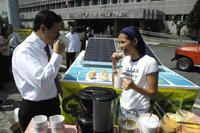

3. Here is what makes Juddha and Neric smile.

4. The Baddest Goodest Banana.

READ MORE!
posted by Redster @ 10:33 AM,
,
![]()
![]()
PRELUDE TO A WRAP-UP
Saturday, November 18, 2006
 PRELUDE TO A WRAP-UP
PRELUDE TO A WRAP-UPIt's the last day of the Nairobi negotiations and it has been frustrating and also exhilarating. For one, my glasses broke a few days ago and I've been getting this dull headache from time to time since then, similar to a low-grade hangover. Work hours during climate treaty events are also notoriously long -- for most of those involved in such negotiations, day in and day out it can be mostly non-stop lobbying, writing articles or position papers, strategizing, coordinating with colleagues and allied organizations, meetings with delegates, patching up political spats and leveraging support for specific measures or issues or positions, putting out 'political brush fires' or igniting indignation. It's been a tough two weeks. Happily, through the Cool The Planet site, blogging with such a wide and diverse group of people has provided a nice, distinct frame to my activities here in Nairobi. We've begun a nice conversation alright, and we've had bloggers, commentators and visitors from virtually all the regions in our planet. The chat box alone showed that climate friends from Iran, Brazil, Italy, Nepal, India, Pakistan, the US, Canada, Korea and New Zealand had dropped by to leave good thoughts and good words for everyone to munch on.
 The posts and the exchanges on this two-week blog has showed that there's really so much that people can share with one another with regard to what is taking place in our climate. Each post actually demonstrates topics and ideas that can allow others to connect to an urgently needed conversation regarding the protection of things that are dear to us and the role played by something we take so much for granted -- our climate -- in our daily rhythms and thoughts and quirks and visions. Climate is literally a huge thing, but it is also so basic. It's a good enough starting point for most everyone to begin thinking about the consequences of how we live today and the impacts of our actions, or inaction.
The posts and the exchanges on this two-week blog has showed that there's really so much that people can share with one another with regard to what is taking place in our climate. Each post actually demonstrates topics and ideas that can allow others to connect to an urgently needed conversation regarding the protection of things that are dear to us and the role played by something we take so much for granted -- our climate -- in our daily rhythms and thoughts and quirks and visions. Climate is literally a huge thing, but it is also so basic. It's a good enough starting point for most everyone to begin thinking about the consequences of how we live today and the impacts of our actions, or inaction.Thankfully, significant negotiation items in Nairobi have moved forward considerably even though many issues have not progressed as far as many thought they would. The more crucial issues have been agreed, however, and next steps have been identified.
 There were times when the negotiations seemed to be stuck hopelessly in bad gridlocks but the process has nonetheless moved forward, allowing many to hope that the agreements achieved in Nairobi will lead to deeper future cuts in global emissions along with the provision of new and much larger funds that can assist the most vulnerable countries to adapt to climatic impacts.
There were times when the negotiations seemed to be stuck hopelessly in bad gridlocks but the process has nonetheless moved forward, allowing many to hope that the agreements achieved in Nairobi will lead to deeper future cuts in global emissions along with the provision of new and much larger funds that can assist the most vulnerable countries to adapt to climatic impacts.It has been a difficult two weeks, with country representatives, UN officials and non-governmental organizations working together or against one another in a humongous attempt to put together an agreement that best serves the individual interests of the UN members -- and the planet. And of course things do not happen the way everyone wants things to happen; self-interest is the predominant mode here, and cynical, persnickety interventions often times marked plenary exchanges, contact group and informal meetings.
Those who would like a more detailed understanding of what the negotiations covered are encouraged to visit the website of the Climate Action Network (CAN), which is the largest and most active global coalition of NGOs working on the issue of climate change. Following the negotiations can be intensely technical and frustrating but CAN continues to do a fine job of combining passions, skills, capacities, experience and insights in order to shepherd and pressure climate treaty negotiations to move forward and remain on track.
 I should have set this down much earlier, obviously, but it has proven difficult to balance regular blog posts and posts mapping the process along with having to attend to my work here as a member of Greenpeace International's delegation, which for two weeks straight was virtually a 6AM to midnight task. In any case, what's done is done -- and with this post what has not been done is now done. Check out the section on who won the daily Fossil of the Day award during the negotiations. This is a prize given to the country delegation that played the most obstructive or destructive role on a given day during the negotiation period. Don't forget to check out the distinguished CAN daily called ECO, which gives delegates -- and the whole process actually -- crucial analysis and positions on the most vital issues throughout a negotiating period. You can actually track the whole negotiations -- including shameful political posturing, hypocritical episodes and lobby gossip -- by reading each ECO issue.
I should have set this down much earlier, obviously, but it has proven difficult to balance regular blog posts and posts mapping the process along with having to attend to my work here as a member of Greenpeace International's delegation, which for two weeks straight was virtually a 6AM to midnight task. In any case, what's done is done -- and with this post what has not been done is now done. Check out the section on who won the daily Fossil of the Day award during the negotiations. This is a prize given to the country delegation that played the most obstructive or destructive role on a given day during the negotiation period. Don't forget to check out the distinguished CAN daily called ECO, which gives delegates -- and the whole process actually -- crucial analysis and positions on the most vital issues throughout a negotiating period. You can actually track the whole negotiations -- including shameful political posturing, hypocritical episodes and lobby gossip -- by reading each ECO issue.
READ MORE!
posted by Redster @ 12:18 AM,
,
![]()
![]()
Balot!!!!
Friday, November 17, 2006
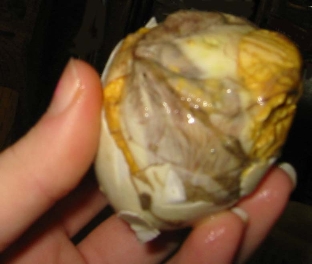
"Baloooooot!!!"
Like a resounding toll of bells, this familiar call of "balooooot!" can be heard every night in most Philippine streets. Balot is it? Online encyclopedia Wikipedia would describe it as "a fertilized duck egg with a nearly-developed embryo inside that is boiled and eaten in the shell." Indeed it is. Peddled at night by (who else but...) balot vendors, it has become a favorite midnight snack and beer companion to Filipinos.
Upon coming home one midnight, I heard once more the now-endangered balot call and reminded me of my long-overdue post about balot. Balot has managed to remind me a couple of important things about life, one of which is climate change and its wrath on the future. See, eating balot is basically eating an aborted duck. Balot is cooked by submerging the egg in boiling water, which consequently cooks the developing duck inside the egg shell. (Heat is the key in producing this Pinoy delicacy). And our future would most likely suffer the same fate as balot if we continue to ignore climate change. No shell can spare us (and the future) from climate change. Aborted futures, that is what the balot is reminding us.
And however annoyingly rousing the balot vendor's midnight call may be, in light of the pressing issue of climate change, a call of its kind is very important. We need a constant reminder of why we need to be involved and why we need to act now!
Only when we've embraced climate change solutions will the balot vendor's call bear a different meaning and sound (at least to me). For now, let "Baloooooot!!!" be a reminder of what we stand to lose if we continue ignoring our climate's yelp for help.
Edited to mention: Thanks to Wikipedia for the picture, don't know whose hand is on the picture but just focus on the balot. Worth a try, especially with a pinch of salt. Yummy.
READ MORE!
posted by The No Show @ 1:04 PM,
,
![]()
![]()
Skate boarding anyone?
Thursday, November 16, 2006
 Skateboarding has entered an era where top riders sign corporate sponsorship contracts with "anti-offensiveness" and "no disparagement" clauses, mainstream television stations like ESPN- Disney's sports division - show the X-Games and skateboarders shred at the Olympics. Thanks to corporations like Nike we can eat extreme pizza, drive Nissan's X-Terra SUV, wear extreme deodorant, hire extreme consulting firms and invest in extreme equity funds. But if we are all extreme now, then where have the real rebels gone? Disappeared in a haze of Ritalin?
Skateboarding has entered an era where top riders sign corporate sponsorship contracts with "anti-offensiveness" and "no disparagement" clauses, mainstream television stations like ESPN- Disney's sports division - show the X-Games and skateboarders shred at the Olympics. Thanks to corporations like Nike we can eat extreme pizza, drive Nissan's X-Terra SUV, wear extreme deodorant, hire extreme consulting firms and invest in extreme equity funds. But if we are all extreme now, then where have the real rebels gone? Disappeared in a haze of Ritalin? The quote above echoes the same sentiments when I along with my girlfriend Jeanie, and her students shot a video of my skateboarding nephew Gato for an advertising project a few weeks ago. The shoot brought back memories a lot of memories including that when I along with other skate buddies rode our boards to a fast descent in at a bypass in Edsa during EDSA 2: Or when I would skip school to skate; or when a 'skate scene' flourished in front of our house in Teachers' Village.
The quote above echoes the same sentiments when I along with my girlfriend Jeanie, and her students shot a video of my skateboarding nephew Gato for an advertising project a few weeks ago. The shoot brought back memories a lot of memories including that when I along with other skate buddies rode our boards to a fast descent in at a bypass in Edsa during EDSA 2: Or when I would skip school to skate; or when a 'skate scene' flourished in front of our house in Teachers' Village.S
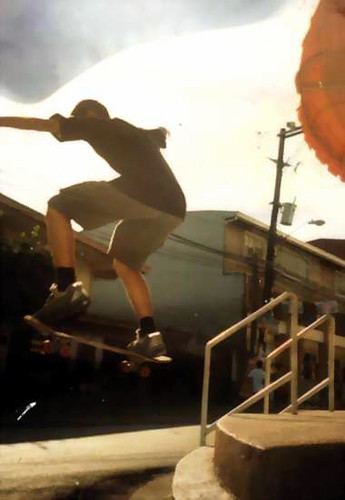 kate-punk no more
kate-punk no more
At that time we were having the time of our lives because it was rebellious, nonconforming and firmly tied to punk rock. It was uncool. People hate us and preppy kids made fun of us for sewing rubber pads on our busted sneakers. But nowadays skateboarding all of a sudden turned hip. Starting with the integration of skateboarding scenes in the videos of jock-core band Limp Bizkit, up to the anthemic 'sk8rboi' trash of Avril Lavigne. It seems that the tables were turned to those of us who skated before the advent of the present status of skateboarding culture in today's youth. It's no wonder why I'm no longer riding my board and play at the scene in front of our house; in fact none of the people I skated with still play there.
I guess the corporate-powers that have come to realize that skaters were a troubling yet alluring demographic for big business.

Light at the end of the tunnel
But as I look at how the skate-punk subculture has faded into obscurity with its marriage to c
 orporate-consumer culture that caters to your average mall-going teen I still see a light at the end of the tunnel...
orporate-consumer culture that caters to your average mall-going teen I still see a light at the end of the tunnel...X-Games 2001 champion Bob Burnquist is an avid Greenpeace supporter and is a part of the Action Sports Environmental Coalition, in fact he's also an organic farmer and grass roots environmentalist. He and his wife had supported Greenpeace work in the Amazon, and were also instrumental in making the 2004 The Summer X Games: extreme and green.
Also skateboarding can be an art, hobby, sport or A METHOD OF TRANSPORTATION. It is common knowledge that climate change is a by product of our dependence in fossil fuels to get us power including to power to drive our cars. It's quite fascinating to think of how much power would be sav
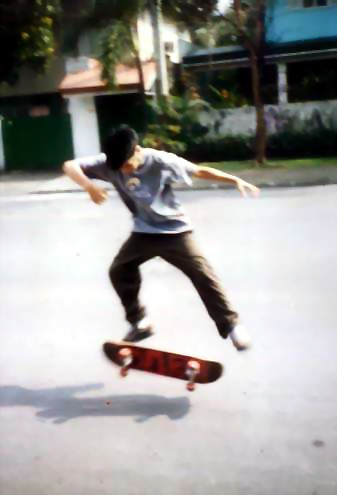 ed if we'd all try out skateboarding, in the same way that we've ride our bikes to school or work.
ed if we'd all try out skateboarding, in the same way that we've ride our bikes to school or work.Thinking about it makes me stoked enough to grab my busted Vans shoe and to ride my board to work while listening to Pennywise or NoFX, how about you?
READ MORE!
posted by m35b @ 4:36 PM,
,
![]()
![]()
Water

Here's another post from Bangalore-based writer Samir. Read it and learn, and tell us later what fluid thoughts you plan to breed, and whether you know of a better escape clause than the person Samir asks at the end of his piece.
WATER
They say water is the source of life, and life was supposed to have started in water - well they cant be wrong. I know quite a few water borne diseases and I do know that water also breeds pests.
There is a town in India called Lakhpat in the state of Gujarat, local folklore has it that the town was so called because it was a very rich town and had many millionaires the verbatim translation in English is a town of millionaires. This was a port town around 300 years back. The town was on the confluence of the river sindh which came in from what is now Pakistan, it was a port town. Slowly the river changed course, today there is no hint that this was once a town of the rich. People have migrated, there are not more than a few families left in the town.
And, water, they say is source of life.
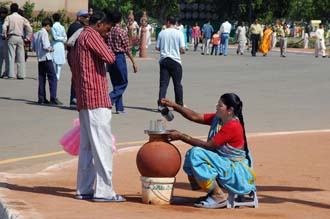 But it is, one of the pointers in the development index is how many people have access to potable water, politicians promise constant water supply if they get elected. There are villages in India that no one wants to marry into because the water there is no longer potable. There is a story that Lord Krishna was cursed by a group of sages because he offered his wife water before he did them.
But it is, one of the pointers in the development index is how many people have access to potable water, politicians promise constant water supply if they get elected. There are villages in India that no one wants to marry into because the water there is no longer potable. There is a story that Lord Krishna was cursed by a group of sages because he offered his wife water before he did them.Those who can afford it will buy water and those who cant – well tough luck. I asked a person if the summers were getting hotter here, he replied in the affirmative and also told me that he had a way out - air conditioners in his house and car.
-samir from India
READ MORE!
posted by COOL THE PLANET @ 2:24 PM,
,
![]()
![]()
DISPATCH FROM NEW YORK!
Monday, November 13, 2006
 Here's a post from Ebong Camarillo, a Filipina teaching in New York, on young folks and learning and why it's never too early to teach the things that matter.
Here's a post from Ebong Camarillo, a Filipina teaching in New York, on young folks and learning and why it's never too early to teach the things that matter.DISPATCH FROM NEW YORK:
HOW LOW CAN YOU GO?
Young minds are a challenge to get through across the board. Often we feel as if we are pulling teeth from them regardless of the fact that they are smart as you can imagine. Teaching middle school age kids pose so much obstacles. My favorite of all is figuring out a lingo that they use as I impart propositions on environmental issues. Are they ready for such vicissitude? Must this be a matter of importance when it derelicts material possession and want? So you reflect and spend a few days on how to inform squirming rug rats on conservation, recycling, preservation, reusing and the big one of all, global warming.
 How young must we teach our children about our only home? John Locke in his empirical view of the human mind that pre-exists as a tabula rasa or a blank slate still holds water for most. Yet the world of obstetrics theorized that as early as the first trimester of child bearing, the young inside the womb; absorbs the world outside. The bucket yields on us no matter what. We teach our kids a million and one things everytime and we wonder, will they be okay at the end of the day? And you see them, choosing to dunk a ball of scrap paper where the can reads "PAPER" and empty juice bottles to dispose of on bins marked "PLASTIC or GLASS". And you smile, and you thank your lucky stars you must be doing something right. It will take a few more of sharing, learning and probably debating before they could relate climate change to fossil fuel addiction. It might feel ages knowing if you are getting through their hyper-passive mode. So, how young should we let them know? May I suggest...as early as we can.
How young must we teach our children about our only home? John Locke in his empirical view of the human mind that pre-exists as a tabula rasa or a blank slate still holds water for most. Yet the world of obstetrics theorized that as early as the first trimester of child bearing, the young inside the womb; absorbs the world outside. The bucket yields on us no matter what. We teach our kids a million and one things everytime and we wonder, will they be okay at the end of the day? And you see them, choosing to dunk a ball of scrap paper where the can reads "PAPER" and empty juice bottles to dispose of on bins marked "PLASTIC or GLASS". And you smile, and you thank your lucky stars you must be doing something right. It will take a few more of sharing, learning and probably debating before they could relate climate change to fossil fuel addiction. It might feel ages knowing if you are getting through their hyper-passive mode. So, how young should we let them know? May I suggest...as early as we can.Visit Ebong's blog for more of her...
READ MORE!
posted by Redster @ 9:11 PM,
,
![]()
![]()
An Orocan is Forever
You know you're Filipino when you have one of these in your bathroom.
Produced by the Ashlar Industrial Corporation in the 1990s, the name 'Orocan' actually stands for their entire line of plastic products; which includes not just their trademark plastic drum, but also laundry basins, coolers, jugs, pitchers, utility storage, etc. But to a Filipino, the word 'Orocan' pertains to the lovely, plastic container you see in the photo; so much so that any large, plastic drum, regardless of the brand, is referred to as an 'Orocan'.
The Orocan is a work of genius. Available in a range of attractive colors, and made of hardy material, the Orocan has evolved only slightly throughout the years, becoming more streamlined. The original ones in the early 90s looked like a plastic version of "Oscar the Grouch's" garbage can. If you look in your lola's (grandmother's) bathroom, you might still be able to find the original, vintage model. That's right, they are never thrown away. No matter how dilapidated they get, they go through a thousand and one incarnations (as you will soon read). An Orocan is forever.
The Orocan has a thousand uses, many of them yet to be invented. It's most common use is as a water storage receptacle. Like all Filipino kids, I have lived through dozens of calamities and natural disasters where we've had to survive without running water for a week: super typhoons, earthquakes, drought, broken pipes, week-long blackouts, coup de etat, and military uprisings (ok, so the last two aren't ' natural disasters, but I'm proud to have lived through a good dozen or so of them). To me, these trying times were marked by freezing-cold, candle-lit baths using our precious water rations, which we scooped out with a tabo (ladle) from (you guessed it) Orocans.
In many Filipino bathrooms, it is not uncommon to find a giant, water-filled Orocan squeezed into the tiny crevice between the toilet and the wall, with a bucket or can floating serenely on the water's surface. Especially in areas where water pressure is weak, many households still flush their toilets the old-fashioned way by pouring torrents of water down the loo, much to many a guest's discomfort I'm sure.
In the summertime, the Orocan makes for a great kiddy-pool. Not only is it less wasteful, requiring less water, but kids get a kick out of being stuffed into tiny, watery, restricting spaces. I should know. As a kid, my mother used to put me in a water-filled Orocan in our driveway on balmy summer afternoons, and I would have a blast.
Aside from being the perfect water-saving device, there are many other creative uses for the Orocan. In the old days, when the lids were still 'Oscar-the-Grouch' inspired, kids would use them as shields when pretending to be Lion-O from 'The Thundercats", Conan the Barbarian, or one of the ninja Turtles (even though they didn't have shields). They were also great places to hide in during games of hide-and-seek.
For the college dormer, the Orocan makes for a lovely side-table or stool when turned upside down; while for the musician, the Orocan can add lively percussion to any song. The possibilities are endless.
And now for my main point (bet you thought I didn't have one!).
Australia is said to be facing it's worst drought in 1000 years. We are reminded of it everyday, on TV, in the news, on flyers you get in your mailbox reminding you of Sydney's on-going water restrictions. We do have a reservoir of recycled water used for flushing our toilets, and watering our lawns. Even then, it's not enough. Australia is a naturally arrid place, due to it's climate. But it seems the dryness has reached an alarming new level.
The local effects, as of now, are that I'm not allowed to water my garden as much as I'd like to. My plants are sad. The national effects include failed crops, a reservoir that is slowly being depleted, and possible drinking-water shortages in certain areas in the future.
They've identified the culprit as climate change. Already, the heat here is blistering on warm days (and I thought there was no place hotter Manila), and Australia is bracing itself for what is expected to be the warmest summer ever.
Australians seems pretty savvy on the issue of climate change (all except their Prime Minister, but I'm not in the mood to get political about this). There seems to be hundreds of on going campaigns on both national and grassroots levels to delay the frightening onslaught of global warming. There is definitely a greater sense of urgency in the fight against global warming here than in the Philippines. But while it's great that people are taking action, I can't help but feel frightened over how real it all is. It's become more than just mere theory. Just ask my plants.
Will I be seeing Orocans in Australian bathrooms in a few years time?
* The Orocan picture was taken from Orocan website.
** You can read more about Australia's drought here.
READ MORE!
posted by koAla Paredes @ 4:15 PM,
,
![]()
![]()
CHAOS AS A COMMON PLACE
 Greenhope reminded us last Wednesday about the drought in Australia, which has resulted in, among other things, a dramatic scarcity of water and "heaps of dangerous snakes coming out looking for food." It could all be quite mesmerizing, if the chaos hammering the planet wasn't so deadly. Still. The loam of thought is a little more fertile.
Greenhope reminded us last Wednesday about the drought in Australia, which has resulted in, among other things, a dramatic scarcity of water and "heaps of dangerous snakes coming out looking for food." It could all be quite mesmerizing, if the chaos hammering the planet wasn't so deadly. Still. The loam of thought is a little more fertile.The truth is, when we change the jurisdictions of certainty, we are also altering the soil of our minds. What manner of stories can arise from the excursion of desperate serpents on increasingly arid land south of our world?
 Everything is changing. Without concerted, urgent action, in as little as twenty five years, the ice caps of Africa's two highest peaks are expected to vanish. On this continent, loss is so final, so vivid. The other day, Richard from Kenya told me about the rapidly desiccating Lake Nakuru, one of the biggest fresh water basins in the country, and the evaporation of the great River Mau which resulted in the mass death of flamingos.
Everything is changing. Without concerted, urgent action, in as little as twenty five years, the ice caps of Africa's two highest peaks are expected to vanish. On this continent, loss is so final, so vivid. The other day, Richard from Kenya told me about the rapidly desiccating Lake Nakuru, one of the biggest fresh water basins in the country, and the evaporation of the great River Mau which resulted in the mass death of flamingos.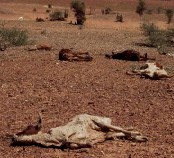 In this age of calamities, the deluge becomes commonplace while extremes of heat and monsoon become regular visitors to the hearth. Reference to all things may change. Even pining. "Announcement during a storm," goes the title of John Iremil E. Teodoro's poem.
In this age of calamities, the deluge becomes commonplace while extremes of heat and monsoon become regular visitors to the hearth. Reference to all things may change. Even pining. "Announcement during a storm," goes the title of John Iremil E. Teodoro's poem."The jalousies are shaking
I imagine that when they shatter
The shards will be as sharp
As my pining for you
Which is wounding the skin
Of my jealousies."
Excerpt from "Panawagan habang bumabagyo," John Iremil E. Teodoro, What the water said: Alon Poems (University of San Agustin, Manila: 2004). Translation by Redster. The flamingo photo is from www.harunhaya.com, the Kilimanjaro pic is from www.diseno-art.com and the Australian drought image is from www.afrol.com.
READ MORE!
posted by Redster @ 3:49 AM,
,
![]()
![]()
HABOOB! DISPATCH FROM SUDAN
Saturday, November 11, 2006
 Yvette, a Filipina, is one of Cool The Planet!'s featured bloggers. From Port Sudan, she weighs in with something that may not entirely be familiar to most Filipinos. Read all about it (yes, that's one humongous sandstorm in the picture...)
Yvette, a Filipina, is one of Cool The Planet!'s featured bloggers. From Port Sudan, she weighs in with something that may not entirely be familiar to most Filipinos. Read all about it (yes, that's one humongous sandstorm in the picture...)HABOOB! DISPATCH FROM SUDAN
No, the clouds didn't fall from the sky; this is not cloud tsunami either. Haboob! This is haboob, sandstorm. It is dust and sand combined with strong winds, and once it hits it will definitely take over your carefully polished floor and sneak into those tiny slots in your neatly placed electronics if you forgot to close your windows and doors. Like a strong typhoon, the haboobwill give you zero visibility as you travel city streets in the midst of its attack.
After living for 11 months in this part of Sudan I have grown familiar with this giant. The only warning we get is the extreme heat prior to its arrival. Sometimes the sky just turns mocha and brings in the dust-laden wind in our midst.
I've heard claims that Khartoum has reached a high of 50 degrees Celsius, this year. I am not surprised there are times when going out of the building is like entering a hot oven. It's extremely hot and dry. The Sudanese say this year has been hotter than previous years; they too can't help but wonder. For us, well, there is no escaping the heat. The only option is to simply wait indoors the whole day, wait for the more friendly night sky, and hope for the arrival of winter.
Winter? In Sudan? Yes, there is winter; there's no snow but the cold winds do come. Many people here look forward to the last quarter of the year. October usually marks the start of the season, but it's already November and the cold winds seem to be evasive and somewhere else.
Abubakr, a Sudanese friend in his mid-twenties explained to me how it was during his teenage years: "I used to wear sweaters at this time of the year, my mother would give me two to be sure that I kept myself warm. Well, not anymore. My younger brothers haven't even experienced it. Too bad for them. I keep wondering why we don't have good cold weather anymore. I remember the draught, maybe its that, hmm I don't know."
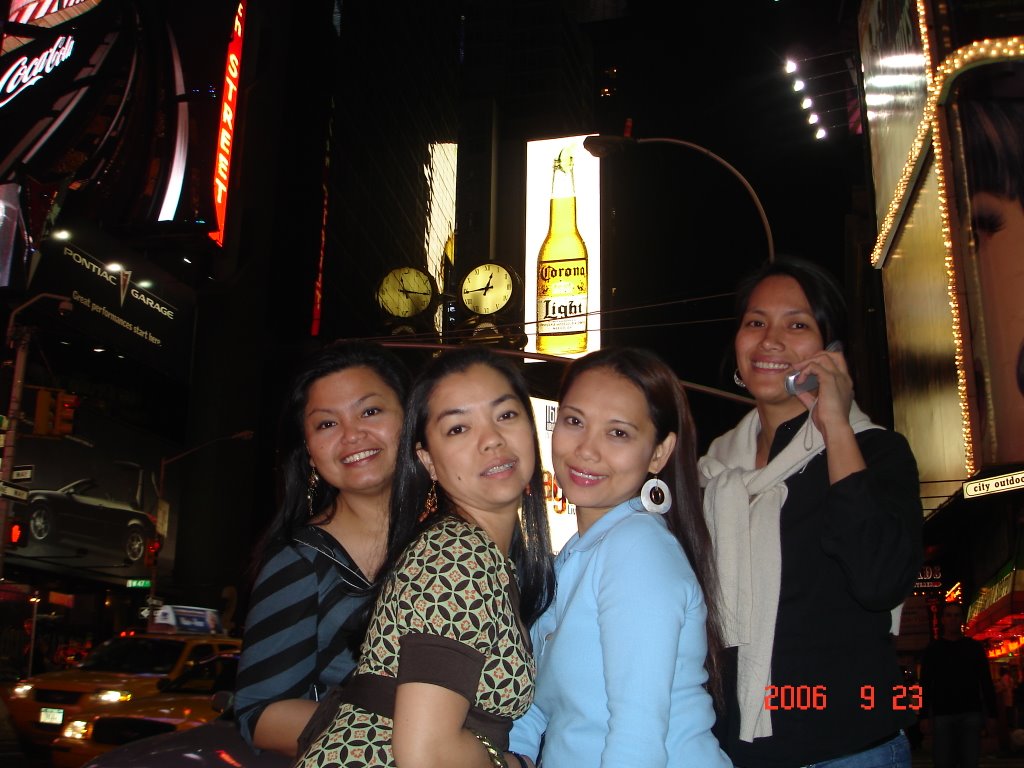 We haven't lost hope, there are still a good number of days before the year reaches its end. We will see the spark of winter at some point and hopefully be allowed by sister haboob to rest.
We haven't lost hope, there are still a good number of days before the year reaches its end. We will see the spark of winter at some point and hopefully be allowed by sister haboob to rest.Sudanese sandstorm photo by Yvette; group pic (Yvette's on the right most in stripes) by Marissa in NYC)
READ MORE!
posted by Redster @ 11:05 PM,
,
![]()
![]()
WATER AND WEEPING
Friday, November 10, 2006
 On the way to the UN conference center today, there was a short protest by members of the youth summit who were holding placards asking delegates to think of their children. It's just about the right time to remind the conference of their obligations. Snags have come up, dirty negotiating tricks have begun, and country representatives have started to retreat to the usual cynical positions defined by sickening self-interest.
On the way to the UN conference center today, there was a short protest by members of the youth summit who were holding placards asking delegates to think of their children. It's just about the right time to remind the conference of their obligations. Snags have come up, dirty negotiating tricks have begun, and country representatives have started to retreat to the usual cynical positions defined by sickening self-interest.I also came across an interesting article in the Khaleej Times of Dubai, which reminded me of the post from CoolMyPlanet blogger Samir, who weighed in from Bangalore about the elements and Indian film and how for some time rain has been shaping images and narratives projected in countless theaters in India.
Rain has a lot to do in Indian cinema, Samir tells us. Rain hides tears, "it is the thin screen that hides love scenes, it accentuates the curves of the curvaceous heroine and generates steam around the panting hero." How true. Similar scenes have also been used in Philippine cinema using rain as a frame. I think this is because the very character of rain inserts its own narrative in any story.
In India, adds Samir, "rain is beyond science, our very social fabric revolves around rains. During periods of low rainfall farmers have had weddings for frogs, have married donkeys - all to please the rain gods." This is an interesting notion, applying human ceremonies on animals in order to plead for favorable weather patterns, the word 'favorable' having come to mean more and more the word 'predictable'. And more and more, climate chaos appears to be the offspring of human kind's marriage with greed and fossil fuels.
 I wonder what Samir will say about the Khaleej Times article on rising sea levels devouring islands in the Sundarbans, which is supposed to be the world's largest estuarine Delta. What are the Sundarbans like? Rising seas certainly have a lot of implications on Philippine cinema, which has for so long used large parts of the tens of thousands of the country's discontinuous coastline as settings for countless movies.
I wonder what Samir will say about the Khaleej Times article on rising sea levels devouring islands in the Sundarbans, which is supposed to be the world's largest estuarine Delta. What are the Sundarbans like? Rising seas certainly have a lot of implications on Philippine cinema, which has for so long used large parts of the tens of thousands of the country's discontinuous coastline as settings for countless movies.I wonder what the effect will be if the world indeed does not wise up and we get more extreme torrential rains and rapidly diminishing coastlines?
Would it mean that tears will have more hiding places?
Would there be more or less love scenes in movies?
 Would more curves be displayed?
Would more curves be displayed?And what will happen to the steaming, panting hero?
One thing for sure, there will be more weeping. On the left, by the way, is Greenpeace volunteer, top model and actress Angel Aquino in the Filipino movie Crying Ladies...
What do you think? Tell us your thoughts. We want to know...
READ MORE!
posted by Redster @ 6:10 PM,
,
![]()
![]()
Climbing Without Shelter!
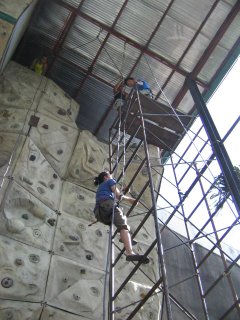
"Must you seize my world by storm?" -Daisy Chain, Cynthia Alexander (of the Philippines)
Indeed, the world of some Pinoy sportclimbers have been seized by a storm called Milenyo. (To Ala: that's what's up here). Just when I was about to resume climbing after months of hiatus due to a knee injury, my favorite indoor climbing gym closed shop. Super-typhoon Milenyo took the gym's roof away, taking with it the routine climbing life of the climbers. It's been over a month now since the unfortunate incident happened and the gym still has no roof. Can't demand for an immediate re-opening, though. Indoor climbing (or rockclimbing per se) is not that big here in the Philippines and I can only wonder how climbing gyms still survive.

And I wonder, too, how we will survive when climate change already brings the worst of its wrath. Climate change is happening right now, alright, and the gym incident made me think how unprepared we are for the impacts of climate change (an example of which is the super-typhoon Milenyo). Something as simple as re-roofing, our gym cannot even afford. Indeed, it is the developing countries which will be hit most by climate change and the sad thing is, we do not have the means to combat it. Will the government's calamity fund, meager as it already is, suffice? Filipino families should probably start having their own calamity fund, that is, if the budget could allow.
It is more than money talks, I believe. Our way of life will be (and is already being) affected by this issue. Just last week, another super-typhoon visited the country and it managed to spoil my beach getaway. I can't help but ask, "when will the erratic weather patterns end," not realizing that these erratic weather patterns are only part of what is in store for us when we continue to ignore climate change! It is just the beginning, friends!
We are climbing without shelter. Climbing, progressing to a future that we are unsure of. Having the gym's roof blown away is already a bummer, but losing my future, our future to climate change? Saying that it's just a bummer is an understatement.
READ MORE!
posted by The No Show @ 1:02 PM,
,
![]()
![]()
BIZARRE ENCOUNTERS IN NAIROBI

Some years ago I visited North Africa -- Morocco, to be exact. It was an amazing place with different sounds, scents and daily rhythms. Such places leave something behind inside your mind, which you somehow always carry around wherever you go.
The same holds for Kenya's fine city, Nairobi. It's my first time in the continent's sub-Saharan region and it's an entirely new place filled with many things so strange and fascinating -- and I'm saying that without having even explored the minutest fraction of Nairobi.
 On the main highway, and at least twice along Uhuru road, I've seen immense Marabou storks perched and plying short routes atop trees along the island in the middle of the boulevard. Now, I grew up in Manila and the birds I encounter there usually do not get any larger than my hand, unless they're pigeons or the rare brave falcon soaring on the outskirts of the metropolis (and they're not beings that you can call large). The Marabou storks, they're something else -- they're humongous and they were on the highway's trees and they looked as big as vultures.
On the main highway, and at least twice along Uhuru road, I've seen immense Marabou storks perched and plying short routes atop trees along the island in the middle of the boulevard. Now, I grew up in Manila and the birds I encounter there usually do not get any larger than my hand, unless they're pigeons or the rare brave falcon soaring on the outskirts of the metropolis (and they're not beings that you can call large). The Marabou storks, they're something else -- they're humongous and they were on the highway's trees and they looked as big as vultures.Maybe it was just a silly Asian awed by the occasional weird thing. In the world of humans, things can often be more bizarre, actually.
 The other day in the UN climate conference in Nairobi, the representative of the Australian government took the floor in a plenary session and beseeched the rest of the delegates to understand empathize with its climate plight. A leading member of the wealthy few and probably the highest carbon dioxide emitter per capita in the world (not to mention the number one exporter of climate-destroying coal), the Australian government continues to play the role of lapdog to the Bush administration with its continued refusal (like the US) to bind itself to dramatic emissions reductions by ratifying the Kyoto Protocol, which can drastically reduce the risks faced by millions of lives due to the threat of dangerous climate change... And as if that was not enough, the Australian negotiator in Nairobi even had the gall to compare his country's vulnerability to climate change during plenary to the extreme vulnerability of impoverished, suffering Africa.
The other day in the UN climate conference in Nairobi, the representative of the Australian government took the floor in a plenary session and beseeched the rest of the delegates to understand empathize with its climate plight. A leading member of the wealthy few and probably the highest carbon dioxide emitter per capita in the world (not to mention the number one exporter of climate-destroying coal), the Australian government continues to play the role of lapdog to the Bush administration with its continued refusal (like the US) to bind itself to dramatic emissions reductions by ratifying the Kyoto Protocol, which can drastically reduce the risks faced by millions of lives due to the threat of dangerous climate change... And as if that was not enough, the Australian negotiator in Nairobi even had the gall to compare his country's vulnerability to climate change during plenary to the extreme vulnerability of impoverished, suffering Africa.It definitely felt freakier listening to the Australian representative plead for understanding than seeing the Marabou stork upfront and personal, a scavenger bird which would probably look cuddly when compared to the hooligan-like behavior of Australia and the US with respect to the Kyoto climate negotiations.
The first marabou photo is from www.zestforbirds.co.za, and the second is from www.harkphoto.com. The last pic is an image of the Australian flag used in the blog post of CAN-Australia coordinator Julie-Anne Richards.
READ MORE!
posted by Redster @ 3:36 AM,
,
![]()
![]()
THE ANSWER IS BLOWIN' IN THE WIND...
Wednesday, November 08, 2006

Today, Nov 7th, is election day in America. Though I have seen several elections come and go during the six years I have lived in the San Francisco-Bay Area, here is one election-issue that is worth saying YES to...it has caused so much debate, oil companies have spent about a 100 million dollars trying to confuse voters to vote against it. Why?
WHAT CAN PROP 87 DO?
PROP 87 will reduce California's dependence on oil and foreign oil (1/2 of our consumption comes from the Middle East!) with alternative sources like BIOFUELS, WIND and SOLAR; it will stop the hold of oil conglomerates on CA energy market and give choices that are cheaper and cleaner. It reduces energy cost and green house emissions. California has the worst air quality in the nation-- mainly concentrated in the Southern Los Angeles area. This law will reduce air pollution that causes asthma, lung disease and cancer.
What do you say? I say Bob Dylan was right 44 years ago -- the answer is blowin' in the wind...
READ MORE!
posted by Jengger @ 7:13 AM,
,
![]()
![]()
NI WAKATI WA KUTENDA!

In Swahili, radiant young Ann of Kenya tells us the title of this post is what the youth today are demanding from their elders: Ni wakati wa kutenda means "It's time for action!" Ann's smile is as bright as the sun and she probably has the same amount of energy too... By the way, the earrings Ann is wearing she made herself, fashioned out of the logo of Solar Generation, the fine, rapidly growing global youth group Ann belongs to...
For young people who have gathered in Nairobi, action means saying no to the things that harm our planet, such as fossil fuels. Action also means embracing solutions, such as wind power.
Wind is common to us. Winds bring change. Wind brings power. Wind brings hope -- renewable hope through renewable power.
I asked some members of the historic first African Youth Summit on Climate Change keeping a watchful eye over the Nairobi climate negotiations what the equivalent of the word "wind" was in their native tongues. Here is what four of them said:
 Elom from Togo: in Ewe, wind is Eya!.
Elom from Togo: in Ewe, wind is Eya!. Catherine from Uganda (right most): in the Runyankole language, wind is Omuyaga!.
Catherine from Uganda (right most): in the Runyankole language, wind is Omuyaga!.Golam (between Ann and Catherine) from India: wind in Hindi is Pavan!.
 Richard from Kenya: in Swahili, wind is Upepo!.
Richard from Kenya: in Swahili, wind is Upepo!.Wind power is a huge part of the solution to climate change. In addition, wind power can provide much-needed jobs while significantly addressing the energy security needs of developing countries such as the Philippines, India and China.
 Elom, Catherine, Ann, Richard and Golam want to know what "wind" is in your language. And while you're at it, maybe you can also tell us what place reminds you best of a memorable breeze that passed your way, whether recently or sometime ago... No secrets ;-)
Elom, Catherine, Ann, Richard and Golam want to know what "wind" is in your language. And while you're at it, maybe you can also tell us what place reminds you best of a memorable breeze that passed your way, whether recently or sometime ago... No secrets ;-)What say you?
READ MORE!
posted by Redster @ 5:01 AM,
,
![]()
![]()
POWER STRUGGLE
Tuesday, November 07, 2006
 it is another ordinary night as you walk into your bedroom after a hard days work, may it be from the two-hour, traffic-laden drive from the office or from the sweat-filled late afternoon bus ride from school and you turn on the switch to instantly literally light up the room where your glorious bed awaits you... what a familiar sight, isnt it? Yet, this normal occurrence could be a source for something wonderful to ponder about as we effortlessly alter the dark to instantaneous brightness,just a simple question we can ask ourselves as we jump into our cots and cradles,how does this important yet seemingly overlooked bulb work?
it is another ordinary night as you walk into your bedroom after a hard days work, may it be from the two-hour, traffic-laden drive from the office or from the sweat-filled late afternoon bus ride from school and you turn on the switch to instantly literally light up the room where your glorious bed awaits you... what a familiar sight, isnt it? Yet, this normal occurrence could be a source for something wonderful to ponder about as we effortlessly alter the dark to instantaneous brightness,just a simple question we can ask ourselves as we jump into our cots and cradles,how does this important yet seemingly overlooked bulb work?Time-warp to grade school, you might say, but, my dear kiddos, lets pay homage to this long-time snubbed appeal. Can you even move without difficulty in the dark? Let us all thank Thomas Edison for that splendid radiant gadget! How can you catch Prison break, Project Runway, the Amazing Race and of course, Spongebob Squarepants? And why did that past super typhoon cause a supreme fuss about the seemingly endless blackout? Indeed, a lot of simple queries can squirm in our minds yet it is answered by complicated although very, very interesting facts!
Can you even recollect who discovered electricity or where on earth it came from? Was it Michael Faraday, who found out that magnetism can produce power?...He probably initiated as well that charm, puppy love and that first kiss are anonymous to electricity. And who can forget the kite-flying Ben Franklin chap who showed that lighting is a form of electrical energy? Then again, where does it PRIMARILY come from? Try asking your buddies around and most of them will come up with gas, water, electrons and neutrons. One friend of mine even thought for awhile and changed the topic! Well, there are a lot of connected theories but to put it simply, the ultimate source of energy is the one thing we blame the heat for: the hot, shiny sun. Its light and warmth are essential for our existence. NOTE, THOUGH, THAT SOME ENERGY RESOURCES ARE QUITE HARMFUL TO THE ENVIRONMENT. but of course, wind power, solar power and modern biomass are the safest bets. I would like to believe, however, that living without electricity is not the end of the world. Still, sadly, life without electricity would be radically different, and a lot more difficult. Hey, I’m all for microwave popcorn, hair-drying and internet surfing!
And as we now notice the complexities of the power of electricity and with the rapid collapse of our natural resources we often neglect, this is one supply we should not slay which, if I may say, we are gradually and unconsciously doing. Aaah yes, from air-conditioners to DVD players, from charging your Ipods to simply switching on the lamp, we are gratefully eons ahead from the head- whacking cavemen because we get to enjoy these holidays of life. However, it is not always Christmas, we should remember that we should not wait for Mr. Potatohead to light up the world. My, theres more I want to utter indirectly yet suitably about power and this country but thats another story.
Now, my dearies, we can reflect and inquire all day about electrical beginnings and wonders and of course, its extinction but you might be too tired to deliberate. So as you close your weary eyes to the still of the night, the poetry of stimulating brainwaves forms the dreams of your new crush. Oh wait! You want to hear about the building which was fueled by cow droppings?
CLICK! Did I wake you, sleepyhead? Oh, that’s the light bulb in your head.
READ MORE!
posted by brainweaver_wan @ 5:15 PM,
,
![]()
![]()
HOPE FOR THE FUTURE OF CORAL REEFS
Greenpeace recently visited the municipality of Dauin and Apo Island as part of the Defending Our Oceans Tour. Highlighting the role of Marine Reserves in ensuring that our oceans remain a
 sustainable resource, the Apo Island Protected Landscape and Seascape has been the model of community-based coastal resource management since the early 1980s.
sustainable resource, the Apo Island Protected Landscape and Seascape has been the model of community-based coastal resource management since the early 1980s.However, Apo Island has not always been a good example of coastal management. Years ago, illegal and destructive fishingpractises were rampant on the island such as the use of dynamite and cyanide as well as muro-ami. It was only when the Silliman University, under the leadership of Dr. Angel Alcala, stepped in and convinced the members of the community that the destruction of their coral reefs is their own loss.
 The protection and management of Apo Island's coral reefs can be attributed to the strong community participation in implementing the project wherein both benefits and responsibilities are shared by the people living on the island. Aside from deputised fish wardens and the local officials, almost everyone on Apo Island is steadfast in guarding their valuable coastal resources. In fact, even children report any unknown vessel that they observe fishing or doing other activities in the surrounding waters of the island.
The protection and management of Apo Island's coral reefs can be attributed to the strong community participation in implementing the project wherein both benefits and responsibilities are shared by the people living on the island. Aside from deputised fish wardens and the local officials, almost everyone on Apo Island is steadfast in guarding their valuable coastal resources. In fact, even children report any unknown vessel that they observe fishing or doing other activities in the surrounding waters of the island.At present, Apo Island is considered the centre for learning of a well-managed marine reserve
 and has hosted countless study tours from all over the Philippines as well as from other countries. Revenues from the park fees are also used to sustain the management and protection of the marine reserve as well as several projects for the community of Apo Island. The municipality of Dauin, through the leadership of the current Mayor Rodrigo Alanano has replicated the experiences from Apo through the establishment of nine (9) marine reserves on the municipality’s coastline. Revenues from these marine reserves alone has contributed greatly to the municipality’s income, around P2 million in 2005, not to mention the benefits of increased fish catch that directly benefits the local fishing communities in Dauin and the rest of the province of Oriental Negros. Aside from these concrete efforts to invest in coastal management, the town also celebrates the Kinaiyahan (Nature) Festival every September 7 as part of the town fiesta featuring presentations centred on the rich cultural heritage of Negros that is anchored on nature.
and has hosted countless study tours from all over the Philippines as well as from other countries. Revenues from the park fees are also used to sustain the management and protection of the marine reserve as well as several projects for the community of Apo Island. The municipality of Dauin, through the leadership of the current Mayor Rodrigo Alanano has replicated the experiences from Apo through the establishment of nine (9) marine reserves on the municipality’s coastline. Revenues from these marine reserves alone has contributed greatly to the municipality’s income, around P2 million in 2005, not to mention the benefits of increased fish catch that directly benefits the local fishing communities in Dauin and the rest of the province of Oriental Negros. Aside from these concrete efforts to invest in coastal management, the town also celebrates the Kinaiyahan (Nature) Festival every September 7 as part of the town fiesta featuring presentations centred on the rich cultural heritage of Negros that is anchored on nature.

Greenpeace returned again to Apo in October to fulfil its promise to help in providing clean and renewable electricity. I was honoured to return and continue what was started during the Defending Our Oceans Tour when we conducted a feasibility study with the assistance of Barangay Captain Mario Pascobello. This time, under the Climate and Energy Campaign led by Abi, a solar energy system was installed on October 19 at the Apo Island
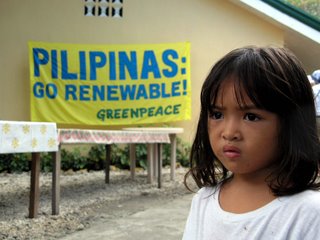 Elementary School library. We were also joined by our fellow staff Beng, together with star power supporters Angel Aquino and Juddha Paolo.
Elementary School library. We were also joined by our fellow staff Beng, together with star power supporters Angel Aquino and Juddha Paolo.Mayor Rodrigo Alanano mentioned during the turn over ceremony that Apo Island’s future does not only rest on its well-managed marine resources but also to have 100% renewable energy by 2010. Coral reefs are very fragile ecosystems and, like the rest of the Earth's ecosystems, are threatened by climate change.
We left knowing that the solar energy installation is a catalyst to add to Apo Island's journey towards a sustainable future. Stay tuned!

READ MORE!
posted by Danny @ 10:47 AM,
,
![]()
![]()




